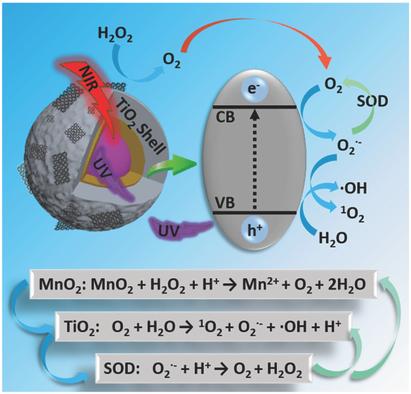当前位置:
X-MOL 学术
›
Adv. Funct. Mater.
›
论文详情
Our official English website, www.x-mol.net, welcomes your
feedback! (Note: you will need to create a separate account there.)
An O2 Self‐Supplementing and Reactive‐Oxygen‐Species‐Circulating Amplified Nanoplatform via H2O/H2O2 Splitting for Tumor Imaging and Photodynamic Therapy
Advanced Functional Materials ( IF 18.5 ) Pub Date : 2017-09-13 , DOI: 10.1002/adfm.201700626 Chi Zhang 1 , Wei-Hai Chen 1 , Li-Han Liu 1 , Wen-Xiu Qiu 1 , Wu-Yang Yu 1 , Xian-Zheng Zhang 1, 2
Advanced Functional Materials ( IF 18.5 ) Pub Date : 2017-09-13 , DOI: 10.1002/adfm.201700626 Chi Zhang 1 , Wei-Hai Chen 1 , Li-Han Liu 1 , Wen-Xiu Qiu 1 , Wu-Yang Yu 1 , Xian-Zheng Zhang 1, 2
Affiliation

|
Conventional photodynamic therapy (PDT) has limited applications in clinical cancer therapy due to the insufficient O2 supply, inefficient reactive oxygen species (ROS) generation, and low penetration depth of light. In this work, a multifunctional nanoplatform, upconversion nanoparticles (UCNPs)@TiO2@MnO2 core/shell/sheet nanocomposites (UTMs), is designed and constructed to overcome these drawbacks by generating O2 in situ, amplifying the content of singlet oxygen (1O2) and hydroxyl radical (•OH) via water‐splitting, and utilizing 980 nm near‐infrared (NIR) light to increase penetration depth. Once UTMs are accumulated at tumor site, intracellular H2O2 is catalyzed by MnO2 nanosheets to generate O2 for improving oxygen‐dependent PDT. Simultaneously, with the decomposition of MnO2 nanosheets and 980 nm NIR irradiation, UCNPs can efficiently convert NIR to ultraviolet light to activate TiO2 and generate toxic ROS for deep tumor therapy. In addition, UCNPs and decomposed Mn2+ can be used for further upconversion luminescence and magnetic resonance imaging in tumor site. Both in vitro and in vivo experiments demonstrate that this nanoplatform can significantly improve PDT efficiency with tumor imaging capability, which will find great potential in the fight against tumor.
中文翻译:

通过H2O / H2O2分裂的O2自补体和活性氧物种循环的放大纳米平台,用于肿瘤成像和光动力疗法
常规的光动力疗法(PDT)由于O 2的供应不足,活性氧(ROS)生成效率低和光的穿透深度低而在临床癌症疗法中的应用受到限制。在这项工作中,设计并构建了一种多功能纳米平台,上转换纳米粒子(UCNPs)@TiO 2 @MnO 2核/壳/片状纳米复合材料(UTM),以通过在原位生成O 2,放大单重态氧的含量来克服这些缺点。(1 O 2)和羟基自由基(•OH)通过水分解,并利用980 nm近红外(NIR)光增加穿透深度。一旦UTM积累在肿瘤部位,细胞内H 2 O2是由催化的MnO 2纳米片,以产生直径:2用于改善依赖于氧的PDT。同时,通过MnO 2纳米片的分解和980 nm NIR辐射,UCNPs可以有效地将NIR转换为紫外光以激活TiO 2并产生有毒的ROS,用于深部肿瘤治疗。另外,UCNP和分解的Mn 2+可以用于肿瘤部位的进一步上转换发光和磁共振成像。体外和体内实验均表明,这种纳米平台可以显着提高PDT的效率和肿瘤成像能力,这将在对抗肿瘤方面具有巨大的潜力。
更新日期:2017-09-13
中文翻译:

通过H2O / H2O2分裂的O2自补体和活性氧物种循环的放大纳米平台,用于肿瘤成像和光动力疗法
常规的光动力疗法(PDT)由于O 2的供应不足,活性氧(ROS)生成效率低和光的穿透深度低而在临床癌症疗法中的应用受到限制。在这项工作中,设计并构建了一种多功能纳米平台,上转换纳米粒子(UCNPs)@TiO 2 @MnO 2核/壳/片状纳米复合材料(UTM),以通过在原位生成O 2,放大单重态氧的含量来克服这些缺点。(1 O 2)和羟基自由基(•OH)通过水分解,并利用980 nm近红外(NIR)光增加穿透深度。一旦UTM积累在肿瘤部位,细胞内H 2 O2是由催化的MnO 2纳米片,以产生直径:2用于改善依赖于氧的PDT。同时,通过MnO 2纳米片的分解和980 nm NIR辐射,UCNPs可以有效地将NIR转换为紫外光以激活TiO 2并产生有毒的ROS,用于深部肿瘤治疗。另外,UCNP和分解的Mn 2+可以用于肿瘤部位的进一步上转换发光和磁共振成像。体外和体内实验均表明,这种纳米平台可以显着提高PDT的效率和肿瘤成像能力,这将在对抗肿瘤方面具有巨大的潜力。











































 京公网安备 11010802027423号
京公网安备 11010802027423号